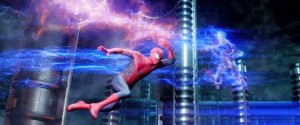
Columbia Pictures’ The Amazing Spider-Man 2 marks not only the return of a superhero but also the culmination of a collaboration between visual effects, sound and post production teams from Sony Pictures Entertainment.
Sony Pictures Imageworks crafted over 1,000 visual effects shots, Sony Pictures Post Production provided sound, in its first project in Dolby Atmos, and Colorworks performed film scanning, conforming and color grading – all in 4K. A new workflow provided the teams with access to data associated with the production, enabling them to work together in close and simultaneous collaboration.
“Our groups have developed a close, creative partnership, aided by remarkable new technologies that allowed them to work across disciplines as one team,” said Randy Lake, executive vice president and general manager, Digital Production Services.
Working under the supervision of senior visual effects supervisor Jerome Chen, Imageworks created a variety of visual effects that blend with live action stunts and performances. Artists created three new villains — Electro, Rhino and Goblin — and developed CG environments representing New York’s Times Square, Manhattan skyscrapers, a next generation hydroelectric plant and an art deco-era clock tower, among many other one-off effects seen throughout the film.
The film’s sound team was led by sound supervisors/designers Addison Teague and Eric Norris, and re-recording mixers Paul Massey and David Giammarco. Working in the newly-renovated William Holden Theater on the Sony lot, Massey and Giammarco mixed the soundtrack natively in Dolby Atmos and finished in Atmos, Auro and 5.1 formats, a combination that has never been done before. At Colorworks, film dailies, amounting to more than 1.5 million feet of 35mm film, were scanned to 4K digital format prior to editorial. The film later returned to Colorworks for conforming, final color grading in 4K and mastering in 2D and stereoscopic 3D.
Collaboration between the teams was facilitated by Sony’s Production Backbone, the studio’s shared storage environment. Original production elements, along with associated metadata, cummulatively amounting to more than 2.4 Petabytes, were stored on the Backbone’s shared-storage environment where it was accessible to sound and picture editors, visual effects artists and others as needed and in appropriate file formats. The Backbone also simplified delivery of elements to external visual effects vendors, who were able to access it through secure, high-speed connections.
“Scanning all of the original film elements at 4K allowed us to work at the highest quality and implement a true digital workflow to the production,” said Bill Baggelaar, senior vice president of technology for Colorworks. “That saved significant time. The Backbone not only provided access to data, it also tracked progress. If an editor or a visual effects artist made a change, it was quickly available to all the other members of the team, increasingly important for quick turn around on a dynamic film like The Amazing Spider-Man 2.”





